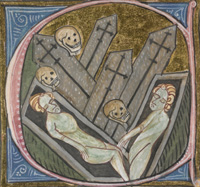 |
 |
 |
 |
 |
 |
 |
|
Death and burial Even Judas, had he died in a Cistercian habit, would have gone to heaven.(1) (1/7) Death was the climax of a monk’s life and the importance of this occasion was marked by the entire community. The approach of death, preparations for burial and the funeral service sparked off a series of rituals for it was believed that the prayer of the monks and lay-brothers for their former brother, and their observance of the appropriate rites would help him progress to salvation. The burial of outsiders Burial within the monastic precinct was highly prized by the laity, for it was believed that those who were physically present forever within these sacred walls would secure a speedier passage to salvation. Remains of tombstones, as well as surviving charters, reveal that a cross section of the laity requested and was granted burial within the precincts of the Cistercian abbeys of Yorkshire.
This was not simply the privilege of founders and those of rank – between 1132 and 1300 over ninety laymen and women sought burial at Fountains Abbey;(3) significantly, some of these were benefactors of other religious houses yet chose to be buried at Fountains, which suggests that the spirituality of the abbey and the prayers offered by the monks there were highly regarded by their contemporaries. A monastic community might benefit considerably from the burial of laity within its precincts, since gifts were often given along with the body for burial. In 1200 x 1208 Stephen of Hamerton gave the monks of Kirkstall twenty loads of hay and his chattels along with his body for burial; Nigel of Horsforth granted the same community his body and land in Horsforth.(4) Some grants were substantial. In the twelfth century Geoffrey Haget granted his body for burial to the monks of Fountains, and also his property and the village of Thorpe.(5) In 1342 the abbot of Louth Park was allegedly so eager to benefit from the death of a local knight that he sent a covered cart to transport the dying man to his monastery so that he could sign over his manor to the community.(6) As well as acquiring gifts, the community might consolidate relations with the donor and his kin, and perhaps secure future help and patronage.
|
